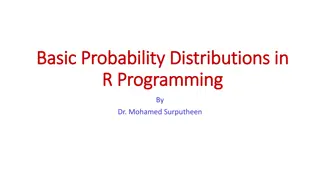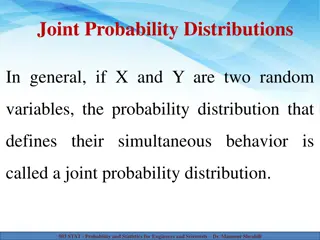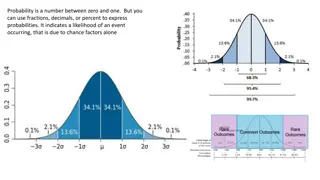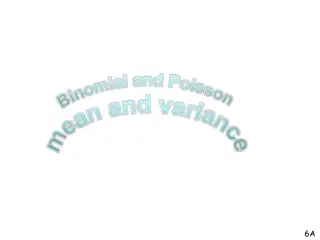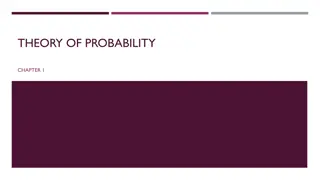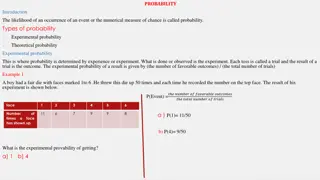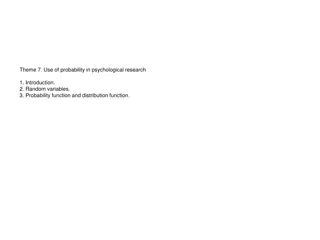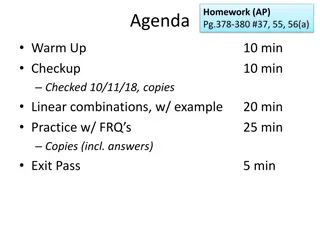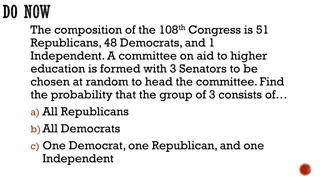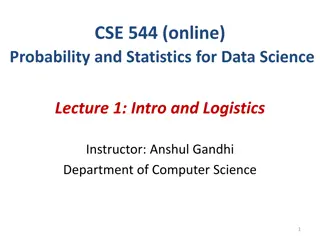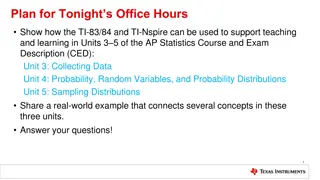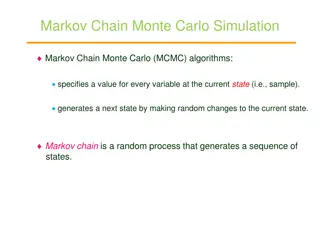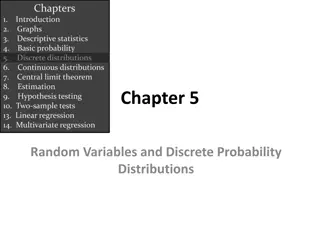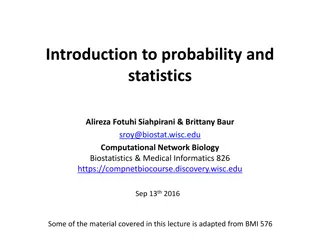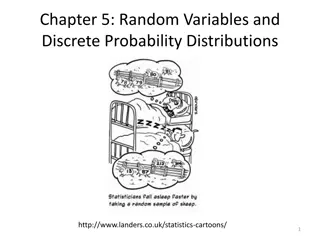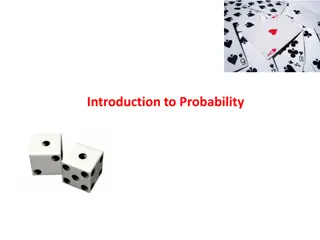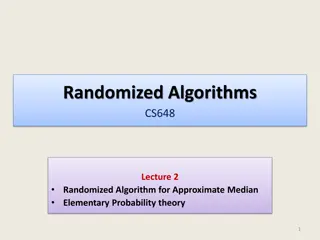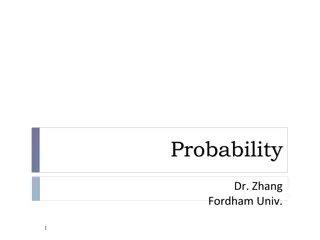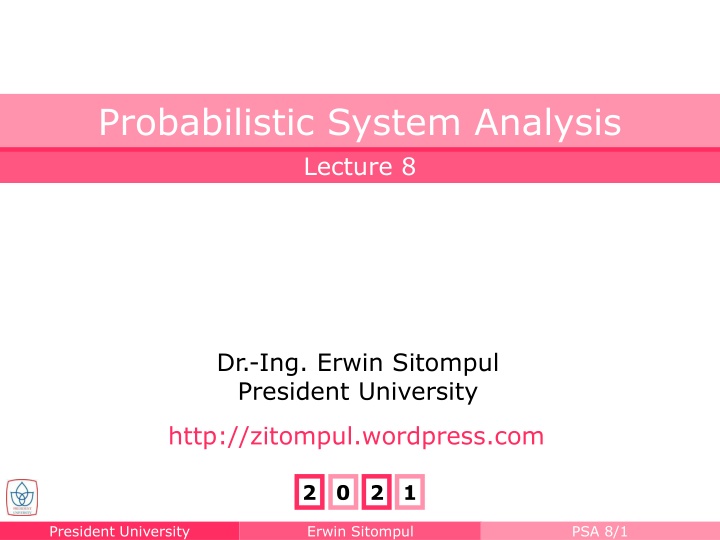
Probability Distributions in System Analysis
This lecture explores various continuous probability distributions, including the uniform distribution and the normal distribution. Understand the probability density functions and characteristics of these distributions. Dive into real-world examples like conference room reservations with uniform distribution and explore the bell-shaped curve of the normal distribution.
Download Presentation

Please find below an Image/Link to download the presentation.
The content on the website is provided AS IS for your information and personal use only. It may not be sold, licensed, or shared on other websites without obtaining consent from the author. If you encounter any issues during the download, it is possible that the publisher has removed the file from their server.
You are allowed to download the files provided on this website for personal or commercial use, subject to the condition that they are used lawfully. All files are the property of their respective owners.
The content on the website is provided AS IS for your information and personal use only. It may not be sold, licensed, or shared on other websites without obtaining consent from the author.
E N D
Presentation Transcript
Probabilistic System Analysis Lecture 8 Dr.-Ing. Erwin Sitompul President University http://zitompul.wordpress.com 2 0 2 1 President University Erwin Sitompul PSA 8/1
Chapter 6 Some Continuous Probability Distributions Chapter 6 Some Continuous Probability Distributions President University Erwin Sitompul PSA 8/2
Chapter 6.1 Continuous Uniform Distribution Continuous Uniform Distribution |Uniform Distribution| The density function of the continuous uniform random variable X on the interval [A,B] is 1 , ( ; , ) 0, elsewhere A x B B A = f x A B The mean and variance of the uniform distribution are A B = = and + 2 ( ) B A 2 2 12 The uniform density function for a random variable on the interval [1, 3] President University Erwin Sitompul PSA 8/3
Chapter 6.1 Continuous Uniform Distribution Continuous Uniform Distribution Suppose that a large conference room for a certain company can be reserved for no more than 4 hours. However, the use of the conference room is such that both long and short conference occur quite often. In fact, it can be assumed that length X of a conference has a uniform distribution on the interval [0,4]. (a) What is the probability density function? (b) What is the probability that any given conference lasts at least 3 hours? 1, 0 4 4 x (a) = ( ) f x 0, elsewhere 4 1 4 1 4 (b) = = 3 P X dx 3 President University Erwin Sitompul PSA 8/4
Chapter 6.2 Normal Distribution Normal Distribution Normal distribution is the most important continuous probability distribution in the entire field of statistics. Its graph, called the normal curve, is the bell-shaped curve which describes approximately many phenomena that occur in nature, industry, and research. The normal distribution is often referred to as the Gaussian distribution, in honor of Karl Friedrich Gauss, who also derived its equation from a study of errors in repeated measurements of the same quantity. The normal curve President University Erwin Sitompul PSA 8/5
Chapter 6.2 Normal Distribution Normal Distribution Acontinuous random variable X having the bell-shaped distribution as shown on the figure is called a normal random variable. The density function of the normal random variable X, with mean and variance 2, is 2 1 2 x 1 ( ; , ) n x = , e x 2 where =3.14159... and e=2.71828... President University Erwin Sitompul PSA 8/6
Chapter 6.2 Normal Distribution Normal Curve 1 < 2, 1 = 2 1 = 2, 1 < 2 1 < 2, 1 < 2 President University Erwin Sitompul PSA 8/7
Chapter 6.2 Normal Distribution Normal Curve f(x) The mode, the point where the curve is at maximum Concave downward Point of inflection Concave upward Approaches zero asymptotically x Symmetry about a vertical axis through the mean Total area under the curve and above the horizontal axis is equal to 1 President University Erwin Sitompul PSA 8/8
Chapter 6.3 Areas Under the Normal Curve Area Under the Normal Curve The area under the curve bounded by two ordinates x = x1 and x = x2 equals the probability that the random variable X assumes a value between x = x1 and x = x2. 2 1 2 x x x 1 2 2 = ( ; , ) n x = ( ) P x X x dx e dx 1 2 2 x x 1 1 President University Erwin Sitompul PSA 8/9
Chapter 6.3 Areas Under the Normal Curve Area Under the Normal Curve As seen previously, the normal curve is dependent on the mean and the standard deviation of the distribution under investigation. The same interval of a random variable can deliver different probability if or are different. Same interval, but different probabilities for two different normal curves President University Erwin Sitompul PSA 8/10
Chapter 6.3 Areas Under the Normal Curve Area Under the Normal Curve The difficulty encountered in solving integrals of normal density functions necessitates the tabulation of normal curve area for quick reference. Fortunately, we are able to transform all the observations of any normal random variable X to a new set of observation of a normal random variableZ with mean 0 and variance 1. X = Z 2 1 2 x x 1 2 = ( ) P x X x e dx 1 2 2 x 1 2 z z 1 2 2 = e dz 2 z 1 z 2 = = ( ) P z Z z ( ;0,1) n z dz 1 2 z 1 President University Erwin Sitompul PSA 8/11
Chapter 6.3 Areas Under the Normal Curve Area Under the Normal Curve The distribution of a normal random variable with mean 0 and variance 1 is called a standard normal distribution. X = Z President University Erwin Sitompul PSA 8/12
Chapter 6.3 Areas Under the Normal Curve Table A.3 Normal Probability Table President University Erwin Sitompul PSA 8/13
Chapter 6.3 Areas Under the Normal Curve Interpolation Interpolation is a method of constructing new data points within the range of a discrete set of known data points. Examine the following graph. Two data points are known, which are (a,f(a)) and (b,f(b)). If a value of c is given, with a<c<b, then the value of f(c) can be estimated. If a value of f(c) is given, with f(a)<f(c)<f(b), then the value of c can be estimated. c a b a ( ) = + ( ) f c ( ) f a ( ) f b ( ) f a ( ) f b ( )? f c ( ) ( ) f b ( ) ( ) f a f c f a ( ) f a ( ) = + b a c a a b ? c President University Erwin Sitompul PSA 8/14
Chapter 6.3 Areas Under the Normal Curve Interpolation P(Z<1.172)? P(Z<z)=0.8700, z=? Answer: 0.8794 1.126 President University Erwin Sitompul PSA 8/15
Chapter 6.3 Areas Under the Normal Curve Area Under the Normal Curve Given a standard normal distribution, find the area under the curve that lies (a) to the right of z=1.84 and (b) between z= 1.97 and z=0.86. (a) = ( 1.84) 1 ( 1.84) P Z P Z 1 0.9671 = = 0.0329 (b) ( 1.94 = = 0.86) ( 0.86) ( 1.94) P Z P Z P Z 0.8051 0.0244 = 0.7807 President University Erwin Sitompul PSA 8/16
Chapter 6.3 Areas Under the Normal Curve Area Under the Normal Curve Given a standard normal distribution, find the value of k such that (a) P(Z>k)=0.3015, and (b) P(k<Z< 0.18)=0.4197. (a) ) 1 = ( ( ) P Z k P Z k ) 1 = ( ( ) P Z k P Z k 1 0.3015 = = 0.6985 k = 0.52 (b) = ( 0.18) ( 0.18) ( ) P k Z P Z P Z k = ( ) ( 0.18) ( 0.18) P Z k P Z P k Z = 0.4286 0.4197 = 0.0089 k = 2.37 President University Erwin Sitompul PSA 8/17
Chapter 6.3 Areas Under the Normal Curve Area Under the Normal Curve Given a random variable X having a normal distribution with = 50 and = 10, find the probability that X assumes a value between 45 and 62. 45 50 10 x = = = 0.5 1 z 1 62 50 10 x = = = 1.2 2 z 2 = ( 0.5 (45 62) 1.2) P X P Z = ( 1.2) ( 0.5) P Z P Z = 0.8849 0.3085 = 0.5764 President University Erwin Sitompul PSA 8/18
Chapter 6.3 Areas Under the Normal Curve Area Under the Normal Curve Given that X has a normal distribution with = 300 and = 50, find the probability that X assumes a value greater than 362. 362 300 50 x = = = 1.24 z = ( 362) ( 1.24) P X P Z = 1 ( 1.24) P Z 1 0.8925 = = 0.1075 President University Erwin Sitompul PSA 8/19
Chapter 6.3 Areas Under the Normal Curve Area Under the Normal Curve Given a normal distribution with =40 and =6, find the value of x that has (a) 45% of the area to the left, and (b) 14% of the area to the right. 0.45 0.4483 0.4522 0.4483 40 ( 0.1256)(6) = + ( ) = + 0.12 ( 0.13) 0.1256 = 0.13 z (a) = ( ) 0.45 P Z z = + = 39.2464 x z 0.4522 0.45 0.4483 0.13 0.12 ? President University Erwin Sitompul PSA 8/20
Chapter 6.3 Areas Under the Normal Curve Area Under the Normal Curve Given a normal distribution with =40 and =6, find the value of x that has (a) 45% of the area to the left, and (b) 14% of the area to the right. = = ( ) 0.14 1 ( ) (b) P z Z P Z z ) 1 0.14 = = ( 0.86 P Z z = 1.08 z = 40 (1.08)(6) + = = + 46.48 x z President University Erwin Sitompul PSA 8/21
Chapter 6.4 Applications of the Normal Distribution Applications of the Normal Distribution A certain type of storage battery lasts, on average, 3.0 years, with a standard deviation of 0.5 year. Assuming that the battery lives are normally distributed, find the probability that a given battery will last less than 2.3 years. 2.3 3.0 0.5 x = = = 1.4 z P Z = ( 1.4) 0.0808 = 8.08% President University Erwin Sitompul PSA 8/22
Chapter 6.4 Applications of the Normal Distribution Applications of the Normal Distribution In an industrial process the diameter of a ball bearing is an important component part. The buyer sets specifications on the diameter to be 3.0 0.01 cm. All parts falling outside these specifications will be rejected. It is known that in the process the diameter of a ball bearing has a normal distribution with mean 3.0 and standard deviation 0.005. On the average, how many manufactured ball bearings will be scrapped? = = = = ( 2 ( P Z 0.9772 0.0228 (2.99 3.01) 2) ( P Z P X P Z 2) 2) 0.9544 2.99 3.0 0.005 3.01 3.0 0.005 x 95.44% accepted = = = 2 1 z 1 4.56% rejected x = = = + 2 2 z 2 President University Erwin Sitompul PSA 8/23
Chapter 6.4 Applications of the Normal Distribution Applications of the Normal Distribution A certain machine makes electrical resistors having a mean resistance of 40 and a standard deviation of 2 . It is assumed that the resistance follows a normal distribution. What percentage of resistors will have a resistance exceeding 43 if: (a) the resistance can be measured to any degree of accuracy. (b) the resistance can be measured to the nearest ohm only. 43 40 2 43) (a) = = 1.5 z = = 1 0.9332 = = = ( ( 1.5) 1 ( 1.5) 0.0668 6.68% P X P Z P Z 43.5 40 2 = = 1.75 z (b) = = 1 0.9599 = = = ( 43.5) ( 1.75) 1 ( 1.75) 0.0401 4.01% P X P Z P Z As many as 6.68% 4.01% = 2.67% of the resistors will be accepted although the value is greater than 43 due to measurement limitation President University Erwin Sitompul PSA 8/24
Chapter 6.4 Applications of the Normal Distribution Applications of the Normal Distribution The average grade for an exam is 74, and the standard deviation is 7. If 12% of the class are given A s, and the grade are curved to follow a normal distribution, what is the lowest possible A and the highest possible B? = ( ) 0.12 = P Z z 1 0.12 = = 0.88 ( ) 1 ( ) P Z z P Z z = = 1.175 + z Lowest possible A is 83 Highest possible B is 82 = 74 (1.175)(7) + = 82.225 x z President University Erwin Sitompul PSA 8/25
Probabilistic System Analysis Homework 8A 1. Suppose the current measurements in a strip of wire are assumed to follow a normal distribution with a mean of 10 milliamperes and a variance of 4 milliamperes2. (a) What is the probability that a measurement will exceed 13 milliamperes? (b) Determine the value for which the probability that a current measurement is below this value is 98%. (Mo.E4.13-14 p.113) 2. A doctor goes from his house to the hospital daily. On average, he will need 24 minutes for a one-way trip. The standard deviation is 3.8 minutes. If the distribution of trip duration can be assumed as normally distributed, find: (a) The percentage of time that the doctor will be late. For information, the hospital opens at 9:00 A.M. and the doctor goes at 8:45 A.M. (b) The probability that 2 of the next 3 trips will take at least 1/2 hour. (Wa.6.15 s.186) President University Erwin Sitompul PSA 8/26

